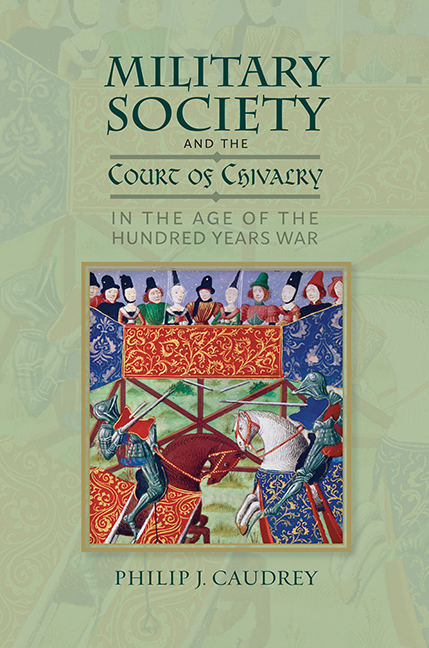Book contents
- Frontmatter
- Dedication
- Contents
- Acknowledgements
- Abbreviations
- Introduction
- 1 Military Service
- 2 Lordship
- 3 Region, Locality and Community
- 4 Soldiers, Civilians and Chivalric Memory
- Conclusion
- Appendix 1 Deponents’ Collective Military Records According to their Own Testimony
- Appendix 2 Lancastrian Retainers: Scrope & Hastings Defendants
- Appendix 3 Plaintiffs’ and Defendants’ Biographies
- Bibliography
- Index
- Warfare in History
- Frontmatter
- Dedication
- Contents
- Acknowledgements
- Abbreviations
- Introduction
- 1 Military Service
- 2 Lordship
- 3 Region, Locality and Community
- 4 Soldiers, Civilians and Chivalric Memory
- Conclusion
- Appendix 1 Deponents’ Collective Military Records According to their Own Testimony
- Appendix 2 Lancastrian Retainers: Scrope & Hastings Defendants
- Appendix 3 Plaintiffs’ and Defendants’ Biographies
- Bibliography
- Index
- Warfare in History
Summary
In 1832, the antiquary Sir Harris Nicolas published two, of what he hoped would be three, volumes on ‘The Controversy between Sir Richard Scrope and Sir Robert Grosvenor’: an armorial case heard before the Court of Chivalry between 1385 and 1390. In justifying his publication of this long-forgotten medieval dispute, Nicolas enthused that he was
farther cheered by the gratifying reflection that these volumes will rescue many of the heroes from oblivion whose prowess at Cressy [sic], Poietiers [sic], Najara [sic], and various other celebrated battles, renders the history of the reign of Edward the Third the brightest page in the annals of British chivalry, and laid the foundation of the military renown of this country.
Unwittingly perhaps, Nicolas’ patriotic focus upon English martial prowess came to set the agenda for almost all future discussions of Scrope v. Grosvenor, and, indeed, additionally came to shape subsequent historical analysis of two other surviving armorial cases heard before the Court of Chivalry: Lovel v. Morley (1386–7) and Grey v. Hastings (1407–10). All three disputes have attracted considerable interest from modern historians, who have utilised them, in far more nuanced fashion, as tools for exploring the military, social and cultural history of the fourteenth-century English gentry. This book seeks to add a further chapter to this rich historiography. Before outlining the overarching themes of the present study, however, a word must be said about the cases themselves, and, more generally, about how the Court of Chivalry arose, how it functioned, what types of cases it heard, the extent to which its records have survived, and why Scrope v. Grosvenor, Lovel v. Morley and Grey v. Hastings have come to enjoy such a prominent position within the existing scholarship on the Court.
Three Armorial Cases
On 20 August 1385, the Yorkshire baron, Richard, Lord Scrope came before the Court of Chivalry and alleged that on Richard II's recent Scottish expedition, Sir Robert Grosvenor of Cheshire had borne Scrope's arms, azure a bend or, contrary to right, for which injury Scrope prayed remedy of the judges.5 Grosvenor, for his part, denied Scrope's accusation, claimed ancestral right to the arms in question, and added for good measure that had he been aware of Scrope possession of the arms, he would have been the one to lay the challenge before the Court.
- Type
- Chapter
- Information
- Publisher: Boydell & BrewerPrint publication year: 2019

